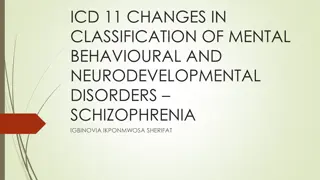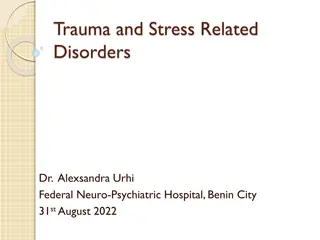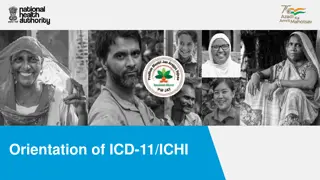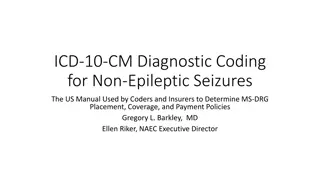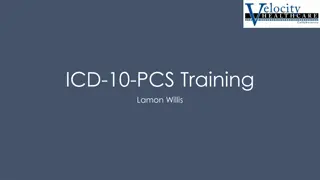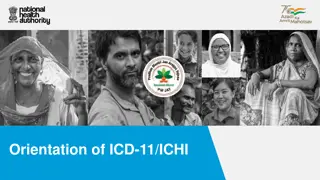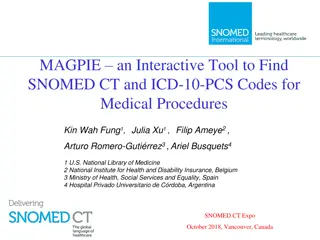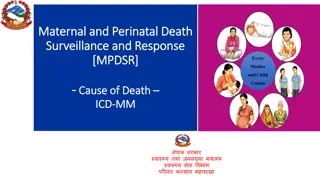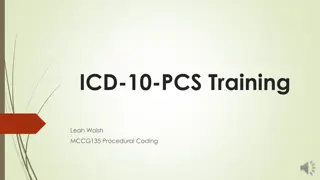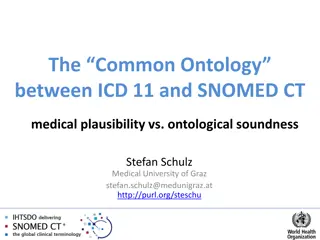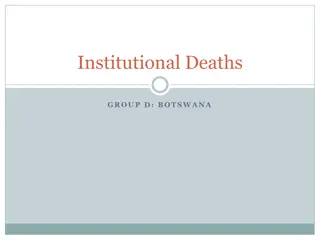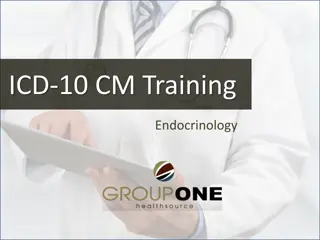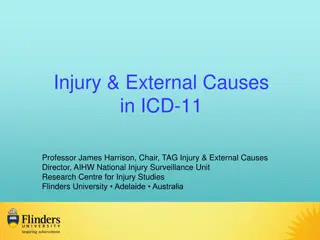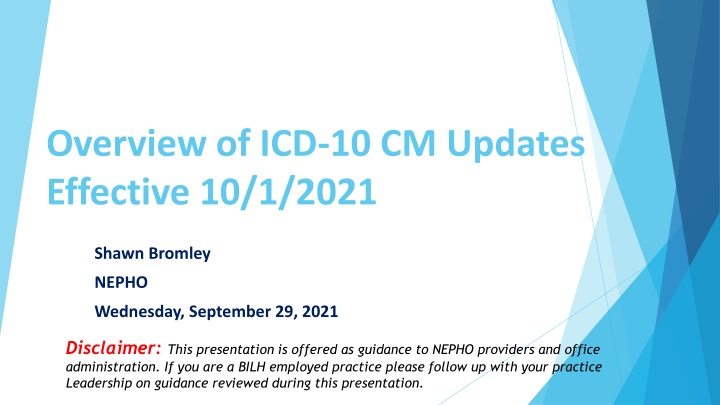
ICD-10-CM Updates Effective October 1, 2021 Highlights
Discover the latest ICD-10-CM updates effective from October 1, 2021, including new code highlights, chapter revisions, and coding guidelines. Stay informed about key changes in healthcare coding.
Download Presentation

Please find below an Image/Link to download the presentation.
The content on the website is provided AS IS for your information and personal use only. It may not be sold, licensed, or shared on other websites without obtaining consent from the author. If you encounter any issues during the download, it is possible that the publisher has removed the file from their server.
You are allowed to download the files provided on this website for personal or commercial use, subject to the condition that they are used lawfully. All files are the property of their respective owners.
The content on the website is provided AS IS for your information and personal use only. It may not be sold, licensed, or shared on other websites without obtaining consent from the author.
E N D
Presentation Transcript
Overview of ICD-10 CM Updates Effective 10/1/2021 Shawn Bromley NEPHO Wednesday, September 29, 2021 Disclaimer:This presentation is offered as guidance to NEPHO providers and office administration. If you are a BILH employed practice please follow up with your practice Leadership on guidance reviewed during this presentation.
Agenda ICD -10 CM Chapter Updates New Code Highlights Chapter Code Breakdown Coding Guidelines Highlights Unspecified Code Review Additional Coding Highlights COVID 19 Chronic Condition Updates Documentation Guidance Update Social Determinants of Health (SDOH) Review Importance of HCC Coding Capture ICD-10 Codes Reset January 1, 2022 Resources
New Code Highlights The fiscal year 2022 ICD-10-CM diagnosis code updates were officially released by the Centers for Medicare and Medicaid Services (CMS) on June 24, 2021 Effective for discharges and encounters on or after October 1, 2021 153 new codes (2021 had 490 new codes) 30 deleted codes (2021 had 58 deleted codes) 22 revised codes (2021 had 47 revised codes) There were also many changes made in the coding instructions in the Tabular. A review of the Tabular Addenda is encouraged to become more familiar with the coding instructions. Chapter 19 has 45 new codes added for 2022 There is a potential that we will have new ICD-10 updates effective April 1st, 2022 Several changes were made in Chapter 18; six new specific codes for coughs (R05) were added, including acute, subacute, chronic, cough syncope, other specified and unspecified.
Chapter 1 Through Chapter 4 Chapter 2: Neoplasms (C00-D49) The first big change involves adding code C84.7A for Anaplastic large cell lymphoma. It is not breast cancer. May affect women who have the textured (rough) type of implants. Two codes were also added to describe primary and secondary malignant neoplasm of bilateral ovaries. Chapter 3: Diseases of blood and blood forming organs and immune mechanism (D50- D89) Expanded new codes for D55.21, Anemia due to pyruvate kinase deficiency and anemia due other disorders of glycolytic enzymes. Chapter New Revised Invalidated Chapter 1: Certain infectious and parasitic diseases (A00-B99) 1 0 0 Chapter 2: Neoplasms (C00-D49) 3 0 0 Chapter 3: Diseases of the blood and blood-forming organs and certain disorders involving the immune mechanism (D50-D89) 5 0 1 Chapter 4: Endocrine, nutritional and metabolic diseases (E00-E89) 1 0 0
Chapter 5 Through Chapter 8 Chapter 5: Mental, Behavioral and Neurodevelopmental Disorders (F01-F99) New code F32.A for Depression. Unspecified or Depression NOS. Previously F32.9, depressive disorder, single episode, unspecified when the depression was not further specified in the record. There are two new codes F78.A2 for SYNGAP related intellectual disability and F78.A9 Other genetic related intellectual disability. Chapter 6: Nervous System (G00-G99) There is a new code G04.82, Acute flaccid myelitis. Acute Flaccid Myelitis (AFM) is an uncommon but serious neurologic condition. It affects the nervous system, specifically the area of the spinal cord called gray matter, which causes the muscles and reflexes in the body to become weak. 90% is in children. Chapter New Revised Invalidated Chapter 5: Mental, Behavioral and Neurodevelopmental disorders (F01-F99) 3 0 1 Chapter 6: Diseases of the nervous system (G00-G99) Chapter 7: Diseases of the eye and adnexa (H00-H59) Chapter 8: Diseases of the ear and mastoid process (H60-H95) 10 1 1 0 0 0 0 0 0
Chapter 9 Through Chapter 12 Chapter 9: Circulatory System (I00-I99) There is a new code I5A for Non-ischemic myocardial injury (non- traumatic) There is a CODE FIRST the underlying cause, if known and applicable, such as: with many conditions listed. Chapter 11: Digestive System (K00-K95) The K22.8 was expanded to K22.81, Esophageal polyp; K22.82, Esophagogastric junction polyp, and K22.89, Other specified disease of esophagus, which includes hemorrhage of esophagus. Additional new codes, K31.A0-K31.A29 for Gastric intestinal metaplasia unspecified, without dysplasia and with dysplasia. Chapter 12: Skin and Subcutaneous Tissue (L00-L99) New codes L24.A0-A9 were added for Irritant contact dermatitis due to fracture, contact with body fluid, saliva, fecal, urinary or dual incontinence or other body fluids. Chapter Chapter 9: Diseases of the circulatory system (I00- I99) New Revised Invalidated 1 0 0 Chapter 10: Diseases of the respiratory system (J00- J99) 1 0 0 Chapter 11: Diseases of the digestive system (K00- K95) 13 0 1 Chapter 12: Diseases of the skin and subcutaneous tissue (L00-L99) 8 0 0
Chapter 13 Through Chapter 16 Chapter 13: Musculoskeletal System (M00-M99) The low back pain code has been expanded to M54.50, low back pain unspecified, M54.51, Vertebrogenic low back pain, and M54.59, Other low back pain. Nerve pain within the spine has long been linked to discs that have degenerated your doctor may refer to this as discogenic pain. But a new term has emerged: vertebrogenic pain. If your doctor discovers that your endplates are the origin of your chronic low back pain, this is the term they may use to diagnose it. Chapter 16: Perinatal Period (P00-P96) New specific code P00.82, Newborn affected by (positive) maternal group B streptococcus (GBS) colonization! It includes contact with positive maternal group B streptococcus. Code P09 has been expanded to P09.1-9 Abnormal findings on neonatal screening for specific diagnoses such as inborn errors of metabolism, congenital endocrine disease, hematological disorders or heart disease, cystic fibrosis, or hearing loss. Chapter Chapter 13: Diseases of the musculoskeletal system and connective tissue (M00-M99) Chapter 14: Diseases of the genitourinary system (N00-N99) Chapter 15: Pregnancy, childbirth and the puerperium (O00-O9A) Chapter 16: Certain conditions originating in the perinatal period (P00-P96) New Revised Invalidated 25 6 3 0 0 0 0 0 0 9 0 1
Chapter 17 Through Chapter 18 Chapter 18: Symptoms, signs, abnormal findings (R00-R99) Cough symptom codes have been expanded to the below: R05.1, Acute cough R05.2, Subacute cough R05.3, Chronic cough R05.4, Cough syncope (with code first syncope and collapse (R55) R05.8, Other specified cough R05.9, Cough, unspecified Cough syncope is a well-known entity which results in loss of consciousness during episodes of cough. It commonly occurs in patients with severe chronic obstructive lung disease (COPD) and asthma. Chapter New Revised Invalidated Chapter 17: Congenital malformations, deformations and chromosomal abnormalities (Q00-Q99) 0 0 0 Chapter 18: Symptoms, signs and abnormal clinical and laboratory findings, not elsewhere classified (R00-R99) 14 0 3
Chapter 19 Chapter 19: Injury, Poisoning, Consequences of External Cause (S00-T88) There are 20 subchapters used to report type of injury, poisoning or complications of trauma or surgical and medical care. S00-S09 Injuries to the head S10-S19 Injuries to the neck S20-S29 Injuries to the thorax S30-S39 Injuries to the abdomen, lower back, lumbar spine, pelvis and external genitals S40-S49 Injuries to the shoulder and upper arm S50-S59 Injuries to the elbow and forearm S60-S69 Injuries to the wrist and hand S70-S79 Injuries to the hip and thigh S80-S89 Injuries to the knee and lower leg S90-S99 Injuries to the ankle and foot T07 Unspecified multiple injuries T14 Injury of unspecified body region T15-T19 Effects of foreign body entering though natural orifice T20-T32 Burns and corrosions T33-T34 Frostbite T36-T50 Poisoning by, adverse effect of, and under-dosing of drugs, medicaments and biological substances T51-T65 Toxic effects of substances chiefly nonmedical as to source T66-T78 Other and unspecified effects of external causes T79 Certain early complications of trauma T80-T88 Complications of surgical and medical care, not elsewhere classified Chapter New Revised Invalidated Chapter 19: Injury, poisoning and certain other consequences of external causes (S00-T88) 45 12 18
Chapter 20 Through Chapter 22 Chapter 21: Factors Influencing Health Status (Z00-Z99) Codes were added for problems related to education and literacy, Inadequate drinking-water, different reasons for homelessness whether shelter or unsheltered, housed with risk of homelessness or homelessness in past 12 months, lack of adequate food, food insecurity and other specified lack of adequate food. The code list is lengthy and contained in code range Z55, Z58, Z59. Chapter 22: Codes for Special Purposes (U00-U49) U09.9 Post COVID-19 condition, unspecified Note: This code enables establishment of a link with COVID-19. This code is not to be used in cases that are still presenting with active COVID-19. Code first the specific condition related to COVID-19 if known, such as: chronic respiratory failure (J96.1-) loss of smell (R43.8) loss of taste (R43.8) multisystem inflammatory syndrome (M35.81)pulmonary embolism (I26.-) pulmonary fibrosis (J84.10) Chapter New Revised Invalidated Chapter 20: External causes of morbidity (V00-Y99) 3 0 0 Chapter 21: Factors influencing health status and contact with health services (Z00-Z99) 11 3 1 Chapter 22: Codes for special purposes (U00-U85) 0 0 0
Coding Guidelines Highlights In the General Coding Guidelines, I.B.2., state that diagnosis codes are to be reported with the highest number of characters available, they added that the codes should reflect the highest level of specificity documented in the medical record. An example might be acute tubular necrosis is diagnosed, but the discharge summary just says AKI, acute kidney injury. Diabetes coding is rectified in the 2022 guidelines. If a patient was maintained on insulin and oral hypoglycemic medication, instructions had previously been to only code the long- term use of insulin. In 2022, we are directed to capture in ICD-10-CM codes both the insulin and any other antidiabetic medications such as oral hypoglycemics or injectable non-insulin medications. Laterality was updated to allow laterality to be coded from clinicians other than the patient s provider. If there are any conflicts, or unspecified, a query is recommended. Unspecified side should rarely be used. If during an encounter, the stage of an un-stageable pressure ulcer is revealed after debridement, assign only the code for the stage revealed following debridement. Use of Z codes, adds that Z codes are appropriate to be captured if there is additional information relevant to a patient encounter.
Accurate Use of Unspecified Codes Unspecified codes are to used when the information in the medical record is insufficient to assign more specific codes. Specific diagnostic codes should ONLY be used when there is enough evidence to support the documentation of the patient s health condition. There are various instances when the documentation is insufficient and the use of Unspecified codes becomes the best alternative to accurately reflect a patient s health care encounter. Each healthcare encounter should be coded up to a certain level of specificity which is known for that encounter. If a certain diagnosis isn t established by the end of the encounter, the use of unspecified codes becomes imperative. Assigning a specific code when sufficient information is not present in the medical record documentation or conducting unnecessary medical tests in order to settle on a specific code can result in claim denials. Payers can request the return of their payment when performing audits of patient medical records, if they feel that a more specific diagnosis could have been reported. Example: A patient visits the physician and reports upper abdominal pain which he has been experiencing for the past five months. The physician doesn t have detailed information about the patient s condition and he further refers him to get various tests and abdominal x-rays done. It is more appropriate for the physician to use the unspecified code rather than guessing that the patient might have a particular diagnosis such as cholecystitis. The correct code would then be R1010 Upper abdominal pain, unspecified
COVID 19 Updates Signs and symptoms without definitive diagnosis of COVID-19 has been revised to reflect new cough ICD- 10-CM specificity. Personal history of COVID-19 is stressed to be without residual symptom(s) or condition(s) in I.C.1.g.1.j. If the patient is following up and still has any symptom or condition related to a previous COVID-19 infection, U09.9 is the go-to code. Multisystem Inflammatory Syndrome (MIS) is expanded upon, detailing the sequencing and relationship with current COVID-19, post COVID-19 condition, and exposure to COVID-19 without known infection. If there are sequela or persistent symptoms or conditions following a previous (and not considered current) COVID-19 infection, U09.9 is the correct code. In anticipation of coding patients who have a previous infection and have been re-infected with another case of COVID-19, there is instruction that U09.9 may be used in conjunction with U07.1. Guidelines: The guidelines edit says that it is for counseling of a patient or caregiver regarding the safety of a vaccine, but it is not for the provision of general information regarding risks and potential side effects during routine encounters for the administration of vaccines. Clearly this is to cover detailed discussions about COVID-19 vaccination or to attempt to overcome any other vaccine hesitancy. The American Academy of Pediatrics requested this new code, and it is intended to be used with Z23, Encounter for immunization or Z28., Immunization not carried out and under-immunization status.
Chronic Condition Capturing 2022 Chronic diseases are defined broadly as conditions that last 1 year or more and require ongoing medical attention or limit activities of daily living or both. In many cases, the individual needs to manage their condition over several years, either through having medical treatment or by changing their lifestyle. Alzheimer s disease Arthritis Chronic obstructive pulmonary disease (COPD) Cancer Depression Diabetes Heart disease High blood pressure High cholesterol Obesity Osteoporosis Stroke It is important to remember that all Chronic Conditions captured for 2021 will reset for the new year and will need to be RECAPTURED in 2022.
Chronic Conditions VS Acute Conditions Acute illnesses generally develop suddenly and last a short time, often only a few days or weeks. Chronic conditions develop slowly and may worsen over an extended period of time months to years. Unlike acute conditions, chronic health conditions cannot be cured only controlled An acute condition can sometimes become chronic, while a chronic condition may suddenly present with acute symptoms. Hepatitis C can typically present with acute symptoms that spontaneously disappear, suggesting that the infection has cleared. However, if left untreated, the infection can progress silently and emerge years later with severe complications like liver failure. The same can occur with non-infectious disorders like rheumatoid arthritis or psoriasis. Both are considered chronic in that they cannot be cured but can be managed with proper care and treatment.
Documentation Updates & Reminders Documentation by Clinicians Other than Patient s Provider the information for laterality, blood alcohol level, as well as social determinants of health can be taken from a clinician s documentation. Of course, the main diagnosis must still be documented by a licensed provider for establishing the patient s diagnosis. Use of Sign/Symptom Unspecified codes, a notation was added that complete documentation is needed for accurate coding and that the entire record should be reviewed to determine the reason for encounter and conditions treated. Here, they are just really stating that unspecified codes are not as helpful as specified codes. Medical conditions due to substance use, abuse, and dependence are not classified as substance-induced disorders. Assign the diagnosis code for the medical condition as directed by the Alphabetical Index along with the appropriate psychoactive substance use, abuse or dependence code. An entirely new subsection, I.C.21.c.17., details SDOH. It states that SDOH should be coded when documented, and that the documentation may come from personnel other than healthcare providers, such as social workers, community health workers, case managers, or nurses. SDOH codes are primarily found in Z55-Z65.
Social Determinants of Health (SDOH) Overview The following list provides examples of the social determinants of health, which can influence health equity in positive and negative ways: Income and social protection Education Unemployment and job insecurity Working life conditions Food insecurity Housing, basic amenities and the environment Early childhood development Social inclusion and non-discrimination Structural conflict Access to affordable health services of decent quality
SDOH Overview (continued) Inequities in health are socially determined, preventing poorer populations from moving up in society and making the most of their potential. Pursuing health equity means striving for the highest possible standard of health for all people and giving special attention to the needs of those at greatest risk of poor health, based on social conditions. Action requires not only equitable access to healthcare but also means working outside the healthcare system to address broader social well-being and development. Health equity is defined as the absence of unfair and avoidable or remediable differences in health among population groups defined socially, economically, demographically or geographically .
SDOH Z Codes Z55.5 Less than a high school diploma Z58 Problems related to physical environment Z58.6 Inadequate drinking-water supply Z59.00 Homelessness unspecified Z59.01 Sheltered homelessness Z59.02 Unsheltered homelessness Z59.4 was revised from Lack of adequate food and safe drinking water to Z559.4 Lack of adequate food Z59.41 Food insecurity Z59.48 Other specific lack of adequate food Z59.81 Housing instability, housed Z59.811 Housing instability, housed with risk of homelessness Z59.812 Housing instability, housed, homelessness in past 12 months X59.819 Housing instability, housed unspecified Z59.89 Other problems related to housing and economic circumstances
Hierarchical Condition Category (HCC) Coding Importance ICD-10 codes mapped to Hierarchical Condition Category (HCC) codes are used to determine the severity of illness of patient panels. New payment models include risk-adjustment factors for patient health status. Physicians should report not only the diagnosis codes that describe why a patient was seen, but also any diagnosis codes associated with chronic conditions that affect treatment choices. Patient risk scores are reset each year, so physicians should comprehensively code chronic conditions at annual visits. Risk-adjustment models assign each patient a risk score based on demographics and health status. Demographic variables may include age, gender, dual Medicare/Medicaid eligibility, whether the patient lives at home or in an institution, and whether the patient has end-stage renal disease. Health status is based on the diagnosis codes submitted on inpatient, outpatient, and professional claims in a calendar year. Certain diagnosis codes map to disease groups (HCCs). Demographics and HCCs are weighted and used to calculate a risk-adjustment factor (RAF) score. The risk score is reset each contract year for individual patients, and only diagnoses reported within that year are used to calculate the score. Individual claims are paid at the contracted rate, but payers use the group's overall risk score to calculate future payment rates and bonuses.
HCC Coding Capture Appropriate capture and documentation of HCC codes is essential for determining accurate patient risk adjustment scores. All chronic conditions should be monitored. Medicare & Commercial payers require that all qualifying conditions be documented at least once a year. Physicians must thoroughly report a patient s risk adjustment diagnosis based on clinical medical record documentation from a face-to-face encounter. The patient medical record should be coded accurately and accompanied by supporting documentation about the status of each condition. To capture the most accurate HCC code, physicians must document all active chronic conditions, including conditions that are relevant to the patient s current care, i.e., the diagnoses being monitored, evaluated, assessed/addressed, or treated. MEAT Each diagnosis should have an assessment and plan, and treatment and level of care must be acceptable. Documentation linked to a non-specific diagnosis, as well as incomplete documentation, can negatively impact patient care and also reimbursement for the services rendered.
Put It All Together: Coding Examples Select not only the diagnosis codes that describe why the patient was seen, but also codes for any chronic conditions that affected treatment choices. Examples: A patient with diabetes presents with severe poison ivy. The physician discusses the diabetes with the patient in deciding whether to use prednisone and documents it in the assessment. The physician should report poison ivy first and diabetes second. A patient followed by nephrology for chronic kidney disease (CKD) is seen by his family physician for hypertension, which is not well controlled. The physician considers and documents the CKD when selecting hypertension treatment, and should report hypertension first and CKD second. A patient with multiple chronic diseases presents for an annual exam. The physician reviews and documents the status of chronic diseases treated within the practice and by other providers. If a patient has a serious chronic condition with a manifestation or complication that has its own code, use that code rather than an unspecified code. Example: Code Type 2 diabetes with retinopathy instead of Type 2 diabetes, uncomplicated or Varicose veins with inflammation or ulcer rather than Varicose veins, unspecified.
Resources Shawn Bromley, NEPHO Director Contracting and Operations Lead Coding Initiatives shawn.m.bromley@lahey.org or 978-236-1704 Jessica Bryan, NEPHO Coder jessica.m.bryan@lahey.org https://www.cms.gov/files/document/fy-2022-icd-10-cm-coding- guidelines.pdf https://www.cms.gov/fy-2022-ipps-final-rule-home-page#Reg https://www.icd10monitor.com/exploring-icd-10-cm-s-chapter-19-injury- poisoning-certain-other-consequences-of-external-causes https://rtwelter.com/blog/2021/05/06/2022-icd10cm-updates-are-just- around-the-corner/ https://yes-himconsulting.com/everything-you-need-to-know-about-the- hcc-risk-adjustment-models/ https://www.miskawaanhealth.com/chronic-disease-prevention/ https://www.cdc.gov/chronicdisease/about/index.htm https://www.verywellhealth.com/chronic-definition-3157059 https://www.ncoa.org/article/chronic-versus-acute-disease


